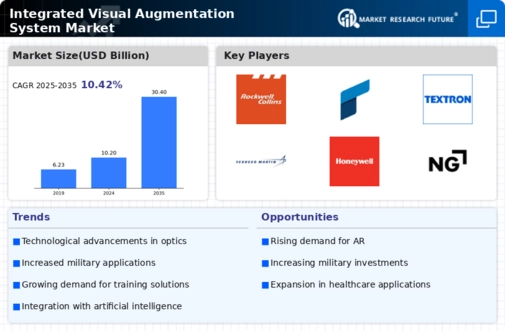The Integrated Visual Augmentation System Market is gaining momentum due to advancements in technology and increasing demand for cutting-edge visual systems across a variety of sectors, including defense, aerospace, and transportation.
A robust competitive environment characterizes this market, with several key players striving to deliver innovative solutions that enhance operational efficiency and situational awareness. Companies are aggressively investing in research and development to create systems that offer superior performance, reliability, and user experience.
The landscape is marked by strategic partnerships, collaborations, and mergers that aim to enhance capabilities and market reach, driving competition further. As the market matures, companies are increasingly focusing on customized solutions, integrating artificial intelligence, augmented reality, and sensor technologies, thereby shaping the future of visual augmentation systems.
Rockwell Collins is a significant player within the Integrated Visual Augmentation System Market, leveraging its extensive expertise in aerospace and defense technologies.
The company is renowned for its advanced visual augmentation solutions that cater to military applications, providing soldiers and operators with enhanced situational awareness, navigation aids, and communication systems.
Rockwell Collins has positioned itself as a trusted partner for defense organizations, emphasizing a strong commitment to innovation and user-centric designs. The company’s focus on integrating next-generation technology into its visual augmentation systems enhances mission capabilities and operational efficiency.
Furthermore, Rockwell Collins’s emphasis on robust customer support and maintenance services adds to its competitive advantage, ensuring that its systems are not only cutting-edge but also reliable and easy to use in challenging environments.
Rheinmetall is another prominent participant in the Integrated Visual Augmentation System Market, dedicated to delivering high-quality visual augmentation solutions tailored for defense applications.
The company has built a reputation for its innovative products that enhance the decision-making capabilities of military personnel by providing them with real-time data and immersive experiences. Rheinmetall’s strengths lie in its advanced technological research and a solid understanding of operational requirements for defense forces around the globe.
The company excels at developing modular and adaptable systems that can be customized to meet specific mission needs, ensuring versatility and effectiveness.
By fostering collaborations with industry partners and leveraging its engineering expertise, Rheinmetall continues to drive advancements in visual augmentation systems, solidifying its presence in the competitive landscape and appealing strongly to defense agencies worldwide.














